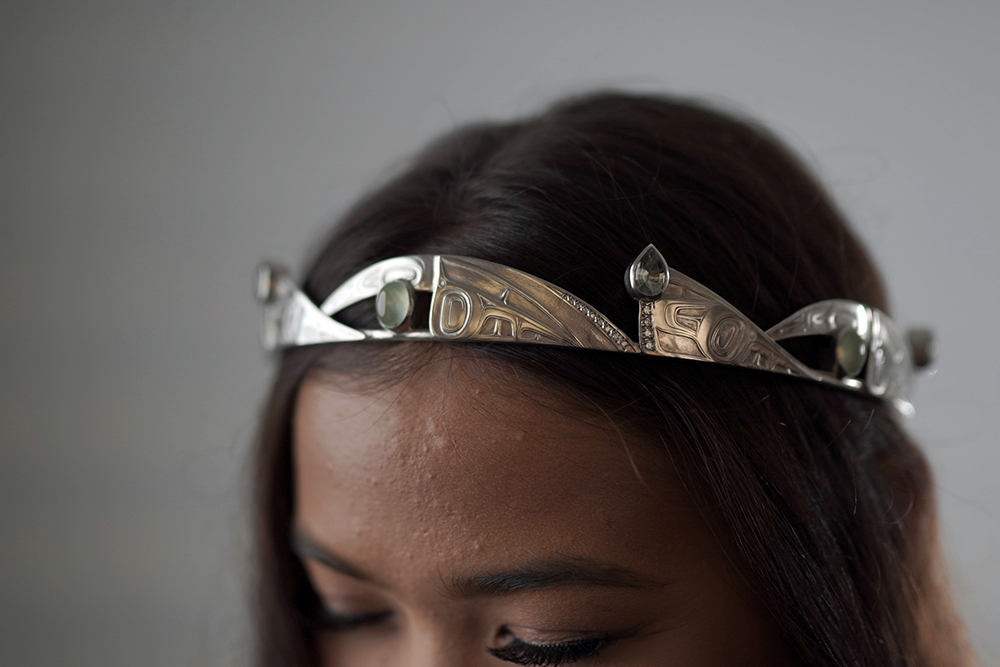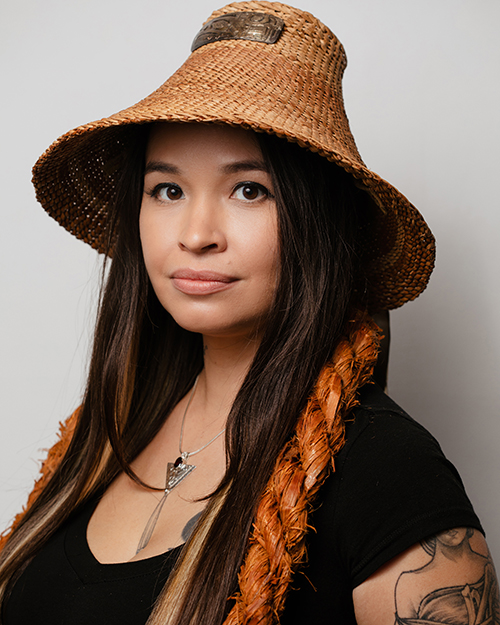
- Details
- By Neely Bardwell
At the Metal Museum in Memphis, Tennessee, a new exhibit just opened that features an Indigenous artist’s exhibition, Royal Portrait, emphasizing the importance of Indigenous matriarchs through reimagining royal regalia and portraiture.
 Morgan Asotyuf portrait (Photo/Courtesy George Lawson Photography)The artist, Morgan Asoyuf, is a Ts’msyen Eagle Clan artist from Ksyeen River (Prince Rupert area), British Columbia, Canada. Asoyuf, 38, has quite the list of experience. She first received a Certificate of Fashion Design from the Blanche Macdonald Centre (Vancouver, BC) before apprenticing under wood sculptors Henry Green (Tsm'syen) and Phil Gray. She has also apprenticed with wood sculptor Richard Adkins (Haida).
Morgan Asotyuf portrait (Photo/Courtesy George Lawson Photography)The artist, Morgan Asoyuf, is a Ts’msyen Eagle Clan artist from Ksyeen River (Prince Rupert area), British Columbia, Canada. Asoyuf, 38, has quite the list of experience. She first received a Certificate of Fashion Design from the Blanche Macdonald Centre (Vancouver, BC) before apprenticing under wood sculptors Henry Green (Tsm'syen) and Phil Gray. She has also apprenticed with wood sculptor Richard Adkins (Haida).
She has also studied bronze casting and even went on to receive diplomas in Jewelry Design and Stone Cutting from the Vancouver Metal Art School. Asoyuf even completed an intensive gem setting program at Revere Academy.
Her work has previously been featured in places such as the Bill Reid Gallery of Northwest Coast Art, the Museum of Vancouver, the Steinbrueck Native Gallery
In Asoyuf’s exhibit, she re-envisions the crowns, scepter, mantles, and jewelry that identify leaders to confront the traditional societal structures that exist. She uses jewelry and photography to shift the view of the power balance towards that of the matriarch.
Asoyuf features Indigenous matriarchs and activists in regalia.
In Ts’msyen culture, the matriarchs hold a special high-ranking position that can be both compared and contrasted to the western concept of royalty. It is the matriarchs job to make sure their community and land are taken care of.
“Today, there is much confusion and struggle in our communities in making these important decisions, especially around land,” writes Asoyuf. “Colonial governments and modern tribal councils often do not respect these inherent rights.”
Issues like Land Back, Missing and Murdered Indigenous Women and Two Spirit Individuals, and environmental sovereignty, are important movements that Asoyuf strives to bring attention to through her work.
“It is a crucial time for our people to create conversations around traditional societal structures, power and leadership,” Asoyuf stated. “We must properly acknowledge our matriarchs.”
Her exhibit will be featured at the Metal Museum Keeler Gallery from now till September 25.
https://www.metalmuseum.org/tributaries-morgan-asoyuf
More Stories Like This
Cherokee Film Helps Bring Indigenous Perspectives to Ken Burns’ ‘The American Revolution’‘Our Common Nature’: Yo-Yo Ma’s New Journey Through Indigenous Landscapes and Sound
Native American Designers You Should Know, Part 01
Cherokee Nation Showcases Growing Film Slate with Fall Premieres of Incentive-Supported Titles
Chickasaw Artists Represent at Southwestern Association for Indian Arts in Santa Fe
Help us tell the stories that could save Native languages and food traditions
At a critical moment for Indian Country, Native News Online is embarking on our most ambitious reporting project yet: "Cultivating Culture," a three-year investigation into two forces shaping Native community survival—food sovereignty and language revitalization.
The devastating impact of COVID-19 accelerated the loss of Native elders and with them, irreplaceable cultural knowledge. Yet across tribal communities, innovative leaders are fighting back, reclaiming traditional food systems and breathing new life into Native languages. These aren't just cultural preservation efforts—they're powerful pathways to community health, healing, and resilience.
Our dedicated reporting team will spend three years documenting these stories through on-the-ground reporting in 18 tribal communities, producing over 200 in-depth stories, 18 podcast episodes, and multimedia content that amplifies Indigenous voices. We'll show policymakers, funders, and allies how cultural restoration directly impacts physical and mental wellness while celebrating successful models of sovereignty and self-determination.
This isn't corporate media parachuting into Indian Country for a quick story. This is sustained, relationship-based journalism by Native reporters who understand these communities. It's "Warrior Journalism"—fearless reporting that serves the 5.5 million readers who depend on us for news that mainstream media often ignores.
We need your help right now. While we've secured partial funding, we're still $450,000 short of our three-year budget. Our immediate goal is $25,000 this month to keep this critical work moving forward—funding reporter salaries, travel to remote communities, photography, and the deep reporting these stories deserve.
Every dollar directly supports Indigenous journalists telling Indigenous stories. Whether it's $5 or $50, your contribution ensures these vital narratives of resilience, innovation, and hope don't disappear into silence.
 The stakes couldn't be higher. Native languages are being lost at an alarming rate. Food insecurity plagues many tribal communities. But solutions are emerging, and these stories need to be told.
The stakes couldn't be higher. Native languages are being lost at an alarming rate. Food insecurity plagues many tribal communities. But solutions are emerging, and these stories need to be told.
Support independent Native journalism. Fund the stories that matter.
Levi Rickert (Potawatomi), Editor & Publisher

